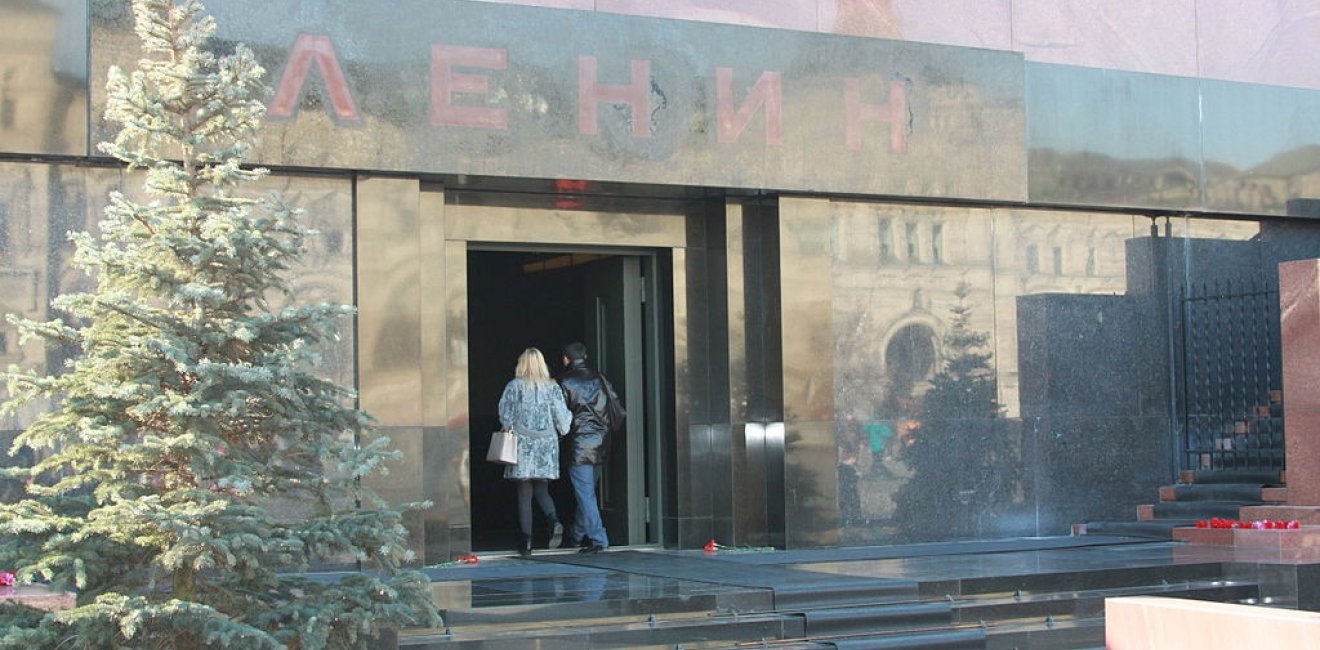
A blog of the Kennan Institute
It’s not every society whose ideals are embodied by a corpse. But in the Soviet Union, the never-decaying body of Vladimir Ilyich Lenin was meant to freeze his ideals in time: a promise to citizens that they were on the collective path to the bright communist future.
Some believed, some did not, but by embalming his body (and against his wishes), his successors meant to cement his place both at the center of Moscow and in the hearts of Soviet citizens. Opened to visitors on August 1, 1924, his mausoleum became a key symbol of Soviet power, from the saint-like aura around Lenin’s remains to the Politburo’s tradition of standing atop the structure on holidays. Today, the unburied body remains a lingering element of the Soviet legacy, representing Russia’s inability or unwillingness to bury its Soviet past.
Unholy, Uneconomical, or Unimportant: Public Opinion on Lenin’s Legacy
Was Lenin a criminal, an ideologue, or someone who died too long ago to matter? Over 20% of Russians (and likely many more who have emigrated) believe the former, some in radical form. In January 2015, two men doused the mausoleum in what they called “holy water,” claiming the need to rid Russia of its Soviet past. Later in 2015, another man stripped naked and lay on the icy cobblestones in front of the mausoleum, demanding that Lenin’s corpse “share his housing.” It was a striking illustration that a corpse has better living conditions than many Russians; maintenance costs were estimated $198,000 in 2016.
Yet for most Russians the corpse is “icky” or “just there,” something they only think about when the pollsters come calling. Based on VTsIOM data from 2017, 38% consider maintenance of the body incorrect and unnatural; 39% view it as a regular tourist object; and 18% believe the leader’s body rightfully belongs in Red Square. Regarding the fate of the body, 32% want Lenin buried immediately; 31% want him buried, but after the generation that “holds Lenin dear” has passed away; and another 31% want the body to stay put.
Lenin himself holds some nostalgia for Russians, but little attention on a daily basis. In a 2017 Levada Center poll, most Russians expressed indifference (34%), followed by respect (26%) and sympathy (14%) toward Lenin. Although 56% believed that Lenin played an entirely or mostly positive role in Russian history—up from 40% in 2006—fewer were able to give concrete answers about what precisely that role was.
Still, for those Russians who hold positive feelings for Lenin, his memory retains a degree of the ideological power that was Soviet doctrine.
The Immortal Corpse
During Soviet years, the scientists charged with keeping up Lenin were called “The Commission for the Immortalization of Lenin’s Memory.” The implication: the immortality of Lenin’s memory was equivalent to the preservation of his appearance. While embalmers prevented physical decay—maintaining the corpse’s external form by manipulating its internal makeup—propaganda, in parallel, constantly strove to prove that his ideals too remained constant. The future was focalized from 1924, imagined at the moment of Lenin’s passing. As Alexei Yurchak has written, this was not merely the immortalization of Lenin, Bolshevik leader: it was the canonization of his ideals in the doctrine of Leninism.
That canonization began even before he was embalmed, with funeral rituals designed to unite the population in mourning—many Russians’ first direct political participation. Nina Tumarkin attributes what she calls “the Lenin cult” to the Party’s re-appropriation of traditional and Orthodox symbols to capture popular support. Love for Lenin was implanted in state propaganda and promoted through statues, songs, art, anecdotes, and of course, the mausoleum. For many, it was also internalized over the Soviet decades.
The embalming phenomenon began with, but was not unique to the Soviet Union—Mao Zedong and Ho Chi Minh are embalmed in their respective countries—but the corpse’s uninterrupted presence after the system it symbolized fell is unique to post-Soviet Russia. With Glasnost, citizens who had long believed in Leninism questioned whether the man in the mausoleum had been a Jew, a syphilitic, even a mushroom, as Sergei Kurekhin set out to prove. Yet even as Lenin retreated from the central spot he had occupied in Soviet ideology and loyal citizens’ consciousness, he remained at the center of Red Square.
Soviet Symbols in Post-Soviet Mentality
With indifference and nostalgia the predominant sentiments toward Lenin, and desire to bury him evenly split between now, later, and never, the Kremlin’s most likely next step is nothing at all. This serves the government’s project of using the past to gesture to Russia’s continued greatness.
The prime example of this isn’t Lenin at all; it is Stalin who remains most alive in Russian cultural memory. Although his body was removed from its spot beside Lenin in 1961, the post-Soviet years have seen him remembered with increasing fondness—reaching a historic maximum this past year when he topped Russia’s list of most remarkable historical figures.
Stalin’s return to popularity aligns with growing pageantry around World War II, the Kremlin’s favorite tool for evoking patriotic sentiment. The weight of sacrifice and pride of victory remain prominent in Russian cultural memory; accordingly, for many, the perception of Stalin as victor over fascism supersedes that of the dictator who killed millions of his own citizens.
An occasionally brutal ruler, but one who brought military victory and unprecedented greatness to Russia, is a safer figure for the current leadership to emphasize than the Bolshevik founding father. After all, not only did Lenin’s policies at times threaten Putin’s holiest of holies, Russian unity and territorial integrity, as William Pomeranz has argued; further, as one of history’s foremost proponents of revolution and upsetting the social order, Lenin is hardly a model for a president whose success rests on the idea that he restored stability to Russia after the chaotic 1990s.
Still, Putin recognizes the symbolic importance of maintaining Lenin’s body for many Russians—including, ironically, those swayed by the popularity of the Soviet past. As Anna Arutunyan, author of a book about Putinism, puts it, “Such an emotional thing as this—it could actually backfire in terms of creating more support for the Communist Party instead of less.”
Lenin’s removal is more likely to cause a stir than his continued presence; people who throw holy water or try to nap next to Lenin, after all, are few. And on the eve of presidential elections in 2018, Putin wants to avoid stirring things up in any way. By letting Lenin lie, Putin alienates no one and maintains the status quo he so relies on.
Long Live the Past, But What About the Future?
The Kremlin’s continued reliance on Soviet symbols fuels a murky understanding of a period marked by repressions on the one hand, and international preeminence on the other. In capitalizing on Russians’ sense of lost greatness, today’s government prevents a true reckoning with the past. The lack of a clear break with Soviet icons—even a 93-years-dead corpse—shows that politics may have changed since the fall of the Soviet Union, but leaders’ reliance not on policy, but on symbols that obfuscate their means of staying in power, remains.
Russian history has rarely seen a smooth transfer of power. Putin’s government today, in coopting a revolutionary corpse as a legitimating symbol of continuity and stability, helps ensure its own place at the top in a Russia marked by passivity and indifference. By maintaining the immortal remains in the center of Moscow, they permit nostalgia for Lenin, but keep Leninism, and revolutionary ideas in general, as quiet as a corpse.
Author

PhD Candidate, Stanford University

Kennan Institute
After more than 50 years as a vital part of the Wilson Center legacy, the Kennan Institute has become an independent think tank. You can find the current website for the Kennan Institute at kennaninstitute.org. Please look for future announcements about partnership activities between the Wilson Center and the Kennan Institute at Wilson Center Press Room. The Kennan Institute is the premier US center for advanced research on Eurasia and the oldest and largest regional program at the Woodrow Wilson International Center for Scholars. The Kennan Institute is committed to improving American understanding of Russia, Ukraine, Central Asia, the South Caucasus, and the surrounding region through research and exchange. Read more

Explore More in The Russia File
Browse The Russia File
Chechnya as a Model of Modern Russia

Russia’s Indigenous Communities and the War in Ukraine

Gas and Power in a Changing US–Russia Relationship

